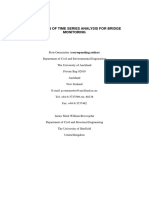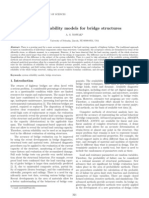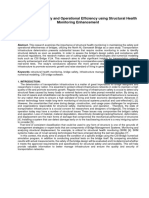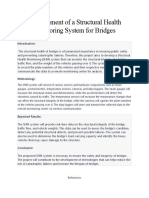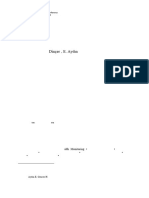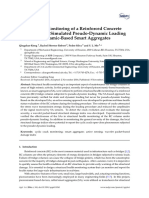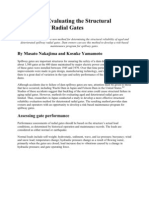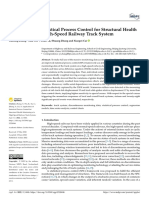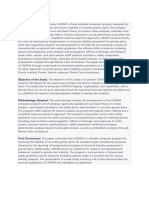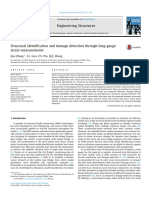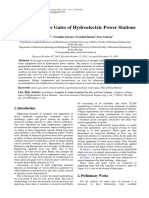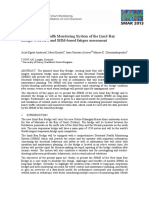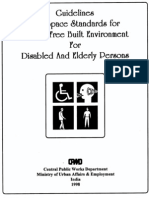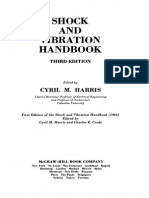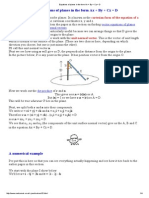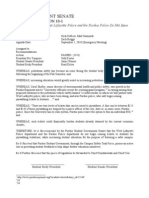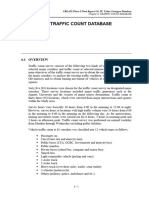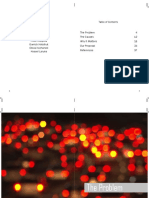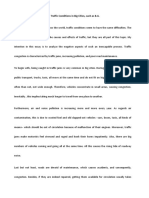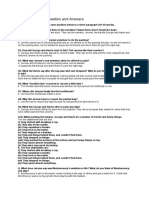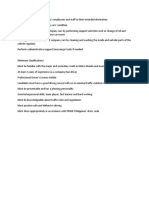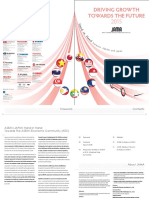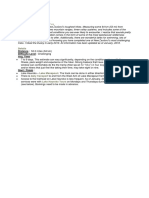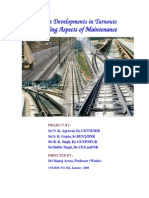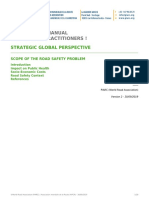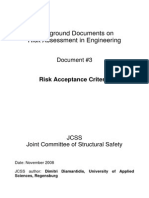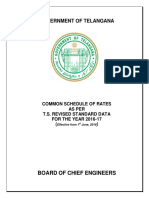Engineering Structures: X.W. Ye, Y.Q. Ni, K.Y. Wong, J.M. Ko
Engineering Structures: X.W. Ye, Y.Q. Ni, K.Y. Wong, J.M. Ko
Uploaded by
Nagesh ThotaCopyright:
Available Formats
Engineering Structures: X.W. Ye, Y.Q. Ni, K.Y. Wong, J.M. Ko
Engineering Structures: X.W. Ye, Y.Q. Ni, K.Y. Wong, J.M. Ko
Uploaded by
Nagesh ThotaOriginal Title
Copyright
Available Formats
Share this document
Did you find this document useful?
Is this content inappropriate?
Copyright:
Available Formats
Engineering Structures: X.W. Ye, Y.Q. Ni, K.Y. Wong, J.M. Ko
Engineering Structures: X.W. Ye, Y.Q. Ni, K.Y. Wong, J.M. Ko
Uploaded by
Nagesh ThotaCopyright:
Available Formats
Statistical analysis of stress spectra for fatigue life assessment of steel bridges
with structural health monitoring data
X.W. Ye
a
, Y.Q. Ni
a,
, K.Y. Wong
b
, J.M. Ko
a
a
Department of Civil and Structural Engineering, The Hong Kong Polytechnic University, Hung Hom, Kowloon, Hong Kong
b
Highways Department, The Hong Kong SAR Government, Hong Kong
a r t i c l e i n f o
Article history:
Received 2 January 2011
Revised 9 June 2012
Accepted 14 June 2012
Available online 24 July 2012
Keywords:
Steel bridge
Structural health monitoring
Fatigue life assessment
Stress spectrum
Typhoon effect
a b s t r a c t
This paper aims at developing a monitoring-based method for fatigue life assessment of steel bridges
with use of long-term monitoring data of dynamic strain. A standard daily stress spectrum is derived
by statistically analyzing the stress spectra accounting for highway trafc, railway trafc, and typhoon
effects. The optimal number of daily strain data for derivation of the standard daily stress spectrum is
determined by examining the predominant factors which affect the prediction of fatigue life. With the
continuously measured dynamic strain responses from the instrumented Tsing Ma Bridge carrying both
highway and railway trafc, the proposed method is exemplied to evaluate the fatigue life of fatigue-
critical welded details on the bridge.
2012 Elsevier Ltd. All rights reserved.
1. Introduction
Steel bridges are subjected to a large number of repetitive load-
ings of different magnitudes caused mainly by the passage of vehi-
cles. They are expected to be vulnerable to fatigue-related damage
and failure [13]. Therefore, it is essential to assess the fatigue
behavior of structural components, especially welded details on
steel bridges. Among the current fatigue analysis methodologies,
the traditional stresslife (SN) approach has been widely used
for fatigue-related design and evaluation of aircraft, offshore struc-
tures, and steel bridges [49]. When the stresslife approach stip-
ulated in specications is adopted for bridge fatigue damage and
life evaluation, it is requisite to know the stress spectra of welded
details in critical locations and the SN curves of the details
[10,11].
The stress spectra can be acquired from a theoretical stress
analysis by assuming a fatigue loading model and a structural
model. The fatigue loading models are usually assumed according
to the specications or obtained based on the measurement data
for a relatively short time, and seldom constructed according to
the statistical treatment of long-term monitoring data under actual
trafc conditions. As to the structural model, the uncertainties in
material properties, geometric congurations, and boundary con-
ditions cannot be entirely considered while the nite element
technique provides a powerful tool in structural modeling and
analysis. Therefore, the accuracy of the simulated stress may be
very limited and a considerable discrepancy between the theoret-
ical analysis results and actual stress status exists in many cases
[12]. The consequence of inaccurate estimation of the stress spec-
tra would be signicant in view of the fact that the predicted fati-
gue life is inversely proportional to at least the cube of the stress
range [13].
It has been shown that fatigue analysis based on the design
specications usually underestimates the remaining fatigue life of
existing bridges by overestimating the live load stress ranges [14].
Fatigue evaluation by using eld monitoring data of strain or stress
under actual trafc loads proves to be a more accurate and efcient
method for existing bridges [15,16]. This can be achieved by using
non-destructive evaluation (NDE) technologies such as the
load-controlled diagnostic load testing and short-term in-service
monitoring. Research efforts have been devoted to fatigue life
assessment of bridges through eld strain measurement [1722].
However, most of these strategies were encountered with the prob-
lems either in disturbing the normal operation of the tested bridge
or only procuring limited data under normal trafc conditions with
a designated time period. Particularly, the NDE technologies are
impossible to be performed and thus incapable of recording the
eld strain time history data under extreme conditions, such as
typhoon, earthquake, and ship collision.
On-line structural health monitoring (SHM), enabled by recent
advances in sensing and data acquisition technologies, communica-
tion algorithms, computational techniques, and data management
systems, has gained worldwide applications in civil engineering
0141-0296/$ - see front matter 2012 Elsevier Ltd. All rights reserved.
http://dx.doi.org/10.1016/j.engstruct.2012.06.016
Corresponding author. Tel.: +852 2766 6004; fax: +852 2334 6389.
E-mail address: ceyqni@polyu.edu.hk (Y.Q. Ni).
Engineering Structures 45 (2012) 166176
Contents lists available at SciVerse ScienceDirect
Engineering Structures
j our nal homepage: www. el sevi er . com/ l ocat e/ engst r uct
eld over the past decade [2331]. It has increasingly become an
important tool for diagnosing and prognosing the structural health
condition and safety status of bridges. With an instrumented bridge
health monitoring system, the continuously eld-measured
dynamic strain data can be acquired and transferred into the stress
spectra resulting from actual trafc and environmental conditions.
The stress spectra thus obtained provide the most authentic and
practical information for fatigue assessment of steel bridges as well
as for decision-making on bridge inspection and maintenance
actions.
In this paper, a monitoring-based stresslife fatigue evaluation
method is proposed and veried using long-term measurement
data acquired by an on-line SHM system permanently installed
on the suspension Tsing Ma Bridge. The daily stress spectra at a
specic location are procured using eld-measured strain time
history data and rainow counting algorithm. In recognizing the
resemblance of the daily stress spectra obtained under normal
trafc and wind conditions, a standard trafc-stress spectrum is
derived by averaging an appropriate number of daily stress spectra.
Likewise, a standard typhoon-stress spectrum is derived using the
eld-measured data during typhoon periods. Then a standard daily
stress spectrum accounting for highway trafc, railway trafc, and
typhoon effects is formulated by synthesizing the two kinds of
stress spectra in accordance with the proportion of typhoon days
in a year. The optimal number of daily strain data for derivation
of a standard daily stress spectrum is determined by examining
the effect of different inuencing factors including the number of
daily strain data, weekend and workday trafc variations, and
seasonal changes in trafc patterns. With such obtained standard
daily stress spectrum, the fatigue life of a critical welded detail
on the bridge is evaluated.
2. Strain measurement data from SHM system
2.1. Tsing Ma Bridge and its SHM system
The Tsing Ma Bridge in Hong Kong, as shown in Fig. 1, is a steel
suspension bridge with a main span of 1377 m and an overall
length of 2160 m. It carries a dual three-lane highway on its upper
level of the bridge deck while two railway tracks and twin single-
lane sheltered carriageways are located on the lower level of the
bridge deck. As a combined highway and railway transport connec-
tion between the Tsing Yi Island and the Lantau Island, it forms a
key part of the most essential transportation network linking the
Hong Kong International Airport to the urban areas.
With the purpose of tracing the structural health conditions of
the bridge, a long-term SHM system, named WASHMS (Wind
And Structural Health Monitoring System) has been implemented
and operated on the Tsing Ma Bridge by the Highways Department
of the Hong Kong Special Administrative Region since its opening
to public trafc in 1997 [32,33]. Based on a modular design concept
[34], the WASHMS was devised to be composed of six integrated
modules, namely Module 1 sensory system (SS); Module 2 data
acquisition and transmission system (DATS); Module 3 data pro-
cessing and control system (DPCS); Module 4 structural health
evaluation system (SHES); Module 5 structural health data man-
agement system (SHDMS); and Module 6 inspection and mainte-
nance system (IMS).
The SS consists of 283 sensors in eight types, including ane-
mometers, servo-type accelerometers, temperature sensors, dy-
namic strain gauges, global positioning systems, displacement
transducers, level sensors, and dynamic weigh-in-motion sensors.
It is purposed to monitor structural and environmental conditions
under operation and to evaluate structural degradation as its oc-
curs through the long-term monitoring of four categories of
parameters, i.e., environmental loads and status, trafc loads,
bridge features, and bridge responses. The DATS comprises on-
structure data acquisition units and optical ber cabling networks
for the acquisition, conversion, temporary storage, and transmis-
sion of signals. On-structure data acquisition units are indispens-
able to SHM systems deployed on long-span bridges and
essential to assuring quality and delity of the acquired data
[26]. The DPCS refers to the hardware and software of a high-per-
formance computer for system control, operation display, and pro-
cessing and analysis of data. The DPCS and SHES, which are key
modules for executing ofine structural health evaluation, are
composed of servers, workstations, and software facilities for data
interpretation, health evaluation, and data management [35]. The
IMS is a laptop-computer-aided portable system for the inspection
and maintenance of the SHM system itself. The SHM system de-
ployed on the Tsing Ma Bridge has operated continuously and stea-
dily for 15 years.
As part of the SHM system, 110 weldable foil-type strain gauges
were installed to measure the strain of structural members under
different loading conditions. As shown in Fig. 1, the locations of
strain gauges include the rail track section at Chainage (CH)
24662.5, bridge-deck trough section at CH24664.75, deck at tower
and rocker bearing links at CH23623, and bridge-deck section at
CH23488. Most of the strain gauges were attached to the fatigue-
prone portions which were identied during the design of the
monitoring system.
In order to assess the fatigue condition of the bridge, 1-year (the
year of 1999) monitoring data of dynamic strain from all 110 strain
gauges have been acquired for strain-based fatigue and condition
assessment. In this paper, the fatigue life evaluation for the most
fatigue-prone detail monitored by the strain gauge SSTLS13 on
the rail track section at CH24662.5 is exemplied. Fig. 2 illustrates
the location of the strain gauge SSTLS13 which was installed under
the bottom ange of the railway beam composed of two inverted
1377m 355.5m 76.5m 23m 300m
72m 72m 72m 72m
206.4m 206.4m
Anchorage
TsingYi Island
Anchorage
Ma Wan Island
78.58m
Tsing Yi Tower
Ma Wan Tower
Str-L(29)
Str-L(30)
Str-R(2)
Str-L(47)
Str-R(2)
C
H
2
3
4
8
8
C
H
2
3
6
2
3
C
H
2
4
6
6
2
.
5
Str-L: linear strain gauge (106)
Str-R: rosette strain gauge (4)
C
H
2
4
6
6
4
.
7
5
Fig. 1. Tsing Ma Bridge and layout of strain gauges.
X.W. Ye et al. / Engineering Structures 45 (2012) 166176 167
T-beams welded to the top ange plate, denoted as Detail H in
Fig. 2a. Fig. 2b shows the sectional view of Detail H.
2.2. Strain measurement data under normal trafc and wind
conditions
The strain data were recorded continuously at a sampling fre-
quency of 51.2 Hz. Fig. 3 shows three typical daily strain time his-
tories obtained from the strain gauge SSTLS13 under normal trafc
and wind conditions (the strain time history measured on a typical
day in 2011 is specically provided for comparison with the daily
strain time histories obtained in 1999). By examining the measure-
ment data, the following observations are made: (i) the daily
straintime curves exhibit some common characteristics in the
shape of curves and magnitude of cycles, and there are almost no
strain pulses from 1:30 am to 5:30 am since the airport railway
ceases its service during this time period; (ii) strain pulses with
large amplitudes appear in each daily strain time history, which
are the strain responses caused by train trafc; and (iii) the overall
drift of the straintime curves is signicant, which is attributed to
the daily cycle effect of temperature variation after conrming its
synchronism with the longitudinal displacement time history con-
currently measured at the expansion joint. This drift does not affect
the calculation of stress range since the stress range depends only
on the difference between the peak and the valley of each stress
cycle. The high coincidence between the strain response data ac-
quired in 1999 (Fig. 3a and b) and those acquired in 2011
(Fig. 3c) demonstrates high durability and excellent performance
of the strain gauges deployed on the Tsing Ma Bridge during a long
working period exceeding 10 years.
The measured strain responses stem mainly from four effects:
highway trafc, railway trafc, wind, and temperature (the static
strain due to initial dead loads is unable to obtain as the strain
gauges were installed after the completion of construction). The
overall drift (slow-varying ingredient) caused by temperature ef-
fect, although quite large, contributes little to the stress because
the majority of temperature-induced strain is released by move-
ment and rotation of the bridge deck at the expansion joint and
bearings. When fatigue assessment methods take into account
stress range only (such as the method used in this study), it is
unnecessary to separate the temperature-induced strain because
it does not affect the calculation of stress range. When mean stress
is required in addition to stress range for fatigue life assessment
[36], stress-irrelevant components have to be eliminated from
the strain measurement data before inferring the corresponding
stress. A wavelet-based multi-component decomposition method
[37] has been developed to eliminate the temperature-induced
ingredient from raw measurement data of strain. It uses the de-
correlation and perfect reconstruction properties of discrete wave-
let transform in multi-resolution analysis and embeds a selection
criterion for physical source extraction. In addition to separating
the temperature-induced strain components, this method is also
competent to remove the spikes and noises corrupted in the mea-
surement data.
2.3. Strain measurement data under typhoon conditions
The Tsing Ma Bridge is located at a region with typhoon wind
climate. A total of ve typhoons, named Leo, Maggie, Sam,
York, and Dan buffeted Hong Kong in 1999. The wind informa-
CL OF BRIDGE
STIFFENER
RAILWAY BEAM WEB
RAILWAY BEAM FLANGE
CROSS FRAME FLANGE
50mm 755mm 755mm
1050mm
2050mm
1050mm
2050mm
1
4
0
0
m
m
SSTLS13
CL
CROSS FRAME FLANGE
TRACK PLATE
(a)
(b)
Fig. 2. Strain gauge SSTLS13 on rail track section at CH24662.5: (a) deck cross-section at CH24662.5; (b) sectional view of Detail H.
168 X.W. Ye et al. / Engineering Structures 45 (2012) 166176
tion during the typhoon attacks was measured by the digital ultra-
sonic anemometers which were deployed on the north and south
sides of the bridge deck at the middle of the main span of the Tsing
Ma Bridge. Each anemometer is able to measure three components
of wind velocity simultaneously. Fig. 4 shows the 10-min mean
wind speed and wind direction, respectively, obtained from the
north anemometer denoted as WITJN01 on August 22, 1999 during
typhoon Sam. The wind direction is measured from east anti-
clockwise. It is seen from Fig. 4 that the maximum 10-min mean
wind speed was 24.03 m/s at about 15:40, August 22, 1999 during
typhoon Sam.
The strain time history data recorded by the monitoring system
during the typhoon attacks are highly valuable for assessing
typhoon-induced fatigue of the bridge. It is usually impossible to
carry out eld testing on a bridge when a typhoon passes over
the bridge because all actions on the bridge have to be stopped
during that period. For the Tsing Ma Bridge, trains across the bridge
to the Hong Kong Airport were still in service during the typhoon
attacks. Fig. 5 gives the measured strain time history acquired by
the strain gauge SSTLS13 on August 22, 1999 during typhoon
Sam. It is observed that the strain time history due to typhoon,
when the highway road was closed, has a pattern different from
00:00 04:00 08:00 12:00 16:00 20:00 24:00
-250
-200
-150
-100
-50
0
Time (hour)
S
t
r
a
i
n
(
1
0
-
6
)
(a)
00:00 04:00 08:00 12:00 16:00 20:00 24:00
-250
-200
-150
-100
-50
0
Time (hour)
S
t
r
a
i
n
(
1
0
-
6
)
(b)
00:00 04:00 08:00 12:00 16:00 20:00 24:00
-150
-100
-50
0
50
100
Time (hour)
S
t
r
a
i
n
(
1
0
-
6
)
(c)
Fig. 3. Measured daily strain time histories under normal trafc and wind conditions: (a) on August 8, 1999; (b) on September 24, 1999; (c) on July 3, 2011.
X.W. Ye et al. / Engineering Structures 45 (2012) 166176 169
that under normal trafc and wind conditions as shown in Fig. 3. A
further observation into Fig. 5 reveals that the typhoon-induced
straintime curve has much more cycles of strain range in large
amplitudes, and the strain values obtained during 12:3016:00
are larger than others, which are in coincidence with the track
and time of typhoon Sam arriving around the Tsing Ma Bridge.
3. Statistical analysis of stress spectra
3.1. Rainow cycle counting technique
When the strain time histories are available, the stress time his-
tories are obtained through simply multiplying the measured
strain data by the elasticity modulus of steel in assumption of elas-
tic strain. The material of steel components of the Tsing Ma Bridge
is Grade Fe 510C as specied in BS EN 10 025 (1990) and the elas-
ticity modulus is 205 GPa. As the strain time histories are com-
posed of many pulses as shown in Fig. 3, it is difcult to dene a
stress cycle directly. Instead, a cycle counting method should be
pursued to transfer the complex irregular stress time histories into
a set of constant stress range frequency data (stress spectrum). In
this study, the rainow cycle counting technique [3840] is
adopted to seek the peaks and valleys in the stress time history
and then extract stress ranges and the number of cycles for each
specic stress range.
3.2. Derivation of standard daily stress spectrum
By executing the rainow cycle counting technique to the stress
time history data covering 1 day, a daily stress spectrum is ob-
tained. Fig. 6 shows the histograms of three typical daily stress
spectra attained under normal trafc and wind conditions by spec-
ifying a resolution of 1 MPa for the stress range interval. The stress
cycles with amplitudes less than 2 MPa are discarded because the
lower valid limit of the strain gauge is 10 micro-strains. A compar-
ison of Fig. 6c with Fig. 6a and b evidences that the trafc amount
on the Tsing Ma Bridge does not have noticeable growth in the past
decade.
An insight into Fig. 6 reveals that the daily stress spectra are
alike for different days under normal trafc and wind conditions.
It is therefore reasonable to average an appropriate number of dai-
ly stress spectra resulting from different days to form a standard
trafc-stress spectrum, as shown in Fig. 7. Similarly, a standard ty-
phoon-stress spectrum can be derived using the strain measure-
ment data obtained under typhoon conditions, as shown in
Fig. 8. It is observed from Fig. 8 that the stress spectrum under ty-
phoon conditions has a pattern different from that under normal
trafc and wind conditions.
After obtaining the standard trafc-stress spectrum and the
standard typhoon-stress spectrum, a more general standard daily
stress spectrum accounting for both trafc (highway and railway)
and typhoon effects can be formulated by proportionally combin-
ing the two standard stress spectra. With such a standard daily
stress spectrum, the fatigue life of the structural detail under
00:00 04:00 08:00 12:00 16:00 20:00 24:00
0
5
10
15
20
25
Time (hour)
M
e
a
n
w
i
n
d
s
p
e
e
d
(
m
/
s
)
(a)
00:00 04:00 08:00 12:00 16:00 20:00 24:00
0
50
100
150
200
Time (hour)
M
e
a
n
w
i
n
d
d
i
r
e
c
t
i
o
n
(
d
e
g
r
e
e
)
(b)
Fig. 4. Mean wind speed and wind direction acquired by anemometer WITJN01: (a)
10-min mean wind speed; (b) 10-min mean wind direction.
00:00 04:00 08:00 12:00 16:00 20:00 24:00
-160
-120
-80
-40
0
20
Time (hour)
S
t
r
a
i
n
(
1
0
-
6
)
Fig. 5. Measured strain time history on August 22, 1999 during typhoon Sam.
170 X.W. Ye et al. / Engineering Structures 45 (2012) 166176
monitoring can be evaluated by regarding that the monitored de-
tail suffers from a block of daily repeated cycles in accordance with
the standard daily stress spectrum. The determination of optimal
number of daily strain data for derivation of a standard daily stress
spectrum will be described in the next section.
4. Monitoring-based fatigue life assessment
4.1. Presentation of procedure
BS5400 Part 10 [10] is a commonly adopted standard for bridge
design, which species methods for fatigue damage and life assess-
ment. The Tsing Ma Bridge was designed according to this stan-
dard. Therefore, the monitoring-based fatigue life evaluation will
also be carried out in accordance with this standard. The methods
for fatigue design and assessment stipulated in BS5400 Part 10 are
based on the Miners rule [41] for fatigue damage accumulation,
which is expressed by
D
X
i
n
i
N
i
1
where D is the fatigue damage accumulation index; n
i
is the speci-
ed number of cycles for the ith stress range, S
i
; and N
i
is the corre-
sponding number of cycles to failure for the ith stress range.
0 10 20 30 40 50 60
0
500
1000
1500
2000
2500
Stress range (MPa)
C
y
c
l
e
s
/
d
a
y
(a)
0 10 20 30 40 50 60
0
500
1000
1500
2000
2500
Stress range (MPa)
C
y
c
l
e
s
/
d
a
y
(b)
0 10 20 30 40 50 60
0
500
1000
1500
2000
2500
Stress range (MPa)
C
y
c
l
e
s
/
d
a
y
(c)
Fig. 6. Histograms of daily stress spectra under normal trafc and wind conditions: (a) on August 8, 1999; (b) on September 24, 1999; (c) on July 3, 2011.
X.W. Ye et al. / Engineering Structures 45 (2012) 166176 171
As stated before, the stress ranges and the corresponding num-
ber of cycles suffered by the structural components under monitor-
ing have been obtained by rainow cycle counting of the strain
measurement data. It is observed in Fig. 6 that the obtained stress
spectra contain a large number of small stress ranges. This is a
common situation for steel bridges [11]. The procedure to treat
the low stress ranges recommended by BS5400 is to reduce the
number of repetitions of each stress range less than the fatigue
limit, S
0
, by multiplying a reducing factor, k
i
, which is dened as
k
i
S
i
=S
0
2
if S
i
< S
0
1 if S
i
> S
0
(
2
In order to calculate the cumulative fatigue damage on a struc-
tural component by the Miners rule, the number of repetitions to
failure of the specied stress range is needed. It is obtained from
the SN curves or SN relationships, which are established from
the experimental results for different materials and different cate-
gories of welded details. The SN curves provided in BS5400 were
formulated through statistical analyses of available experimental
data (linear regression analysis of logS and logN) with minor
empirical adjustments to ensure the compatibility of results be-
tween various categories, in which the stresslife relation is repre-
sented by
N S
m
K
0
D
d
3
where N is the predicted number of cycles to failure for a stress
range, S; m is the inverse slope of the mean-line logSlogN curve;
K
0
is a constant relating to the mean-line logSlogN curve; D is
the reciprocal of the anti-log of the standard deviation of logN;
and d is the number of standard deviations below the mean-line
logSlogN curve, which is also called the probability factor of which
different values correspond to different probabilities of failure.
Each connection detail subject to uctuating stress should,
where possible, have a particular class designated in BS5400. The
detail of the weld joint near to the strain gauge SSTLS13 is shown
in Fig. 2. It is categorized as class F
2
according to BS5400.
According to the Miners rule, the total cumulative fatigue dam-
age should not be greater than unity; otherwise the structural com-
ponent will be considered to have fatigue failure. The Miners
summation in accordance with the standard daily stress spectrum
represents the cumulative fatigue damage generated per day on
the structural component monitored. Consequently, when the fati-
gue life F is represented in terms of number of years, it is obtained
fromthe standard daily stress spectrumand the SN relationship as
F
1
365
X
i
k
i
n
i
N
i
4
A owchart illustrating the monitoring-based fatigue life
assessment method is given in Fig. 9. Firstly, the original measure-
ment data of structural strain are retrieved from the SHM system
and preprocessed to remove the spikes and noises [37]. Then, the
strain time history is converted into the stress time history by sim-
ply multiplying the elasticity modulus of material. After obtaining
the stress time history, the rainow counting algorithm is used to
determine the stress range and number of cycles. Subsequently,
the standard stress spectrum is derived by statistically analyzing
0 10 20 30 40 50 60
0
500
1000
1500
2000
2500
3000
Stress range (MPa)
C
y
c
l
e
s
/
d
a
y
Fig. 7. Standard trafc-stress spectrum.
0 10 20 30 40 50 60
0
500
1000
1500
2000
2500
3000
Stress range (MPa)
C
y
c
l
e
s
/
d
a
y
Fig. 8. Standard typhoon-stress spectrum.
172 X.W. Ye et al. / Engineering Structures 45 (2012) 166176
the stress spectra accounting for the trafc characteristics and
external loads. Finally, the fatigue life of the structural component
is calculated by using the SN curve method together with the
Miners rule.
4.2. Determination of optimal number of daily strain data
A major issue in converting the eld strain data to construct
stress range frequency is the duration of the data acquisition pro-
cess. In general, a 2- or 3-day period for highway bridges and a 5-
to 10-day period for railway bridges are sufcient since during
such a period nearly all stress ranges experienced by critical com-
ponents in a bridge can be captured [19]. For the Tsing Ma Bridge
which carries not only highway but also railway trafc, the strain
data have been acquired continuously by the on-line SHM system.
It provides a good chance to establish a realistic representation of
entire stress ranges and their frequencies. On the other hand, it is
impractical and time-consuming to take all daily strain data into
account in the fatigue life evaluation. In the following, we investi-
gate the inuence of number of daily strain data on the predicted
fatigue life with the purpose of seeking an optimal number of daily
strain data to formulate the standard daily stress spectrum.
Eighty-day measurement data obtained from the strain gauge
SSTLS13 under normal trafc and wind conditions are selected
for this purpose. Principally, each daily stress spectrumcan be used
to predict a fatigue life at this detail. Fig. 10 shows the predicted
fatigue life from the individual daily stress spectra sorted in an
ascending order. It is obvious that the predicted fatigue life is dif-
ferent from different daily stress spectra, ranging from 620 to
1001 years. The reason which can be easily understood is because
the live load really exerted on the bridge is different in each spe-
cic day.
Table 1 lists the fatigue life predicted using different number of
daily strain data randomly extracted from the 80 days. Firstly, 5
daily strain data are used and drawn out randomly from 80 daily
strain data, and the involved dates will be included in the next cal-
culation; the rest is deduced by analogy. It is seen that the pre-
Collection of data from SHM
Preparation of strain time history
Convert the strain time history
into stress time history
Elasticity modulus
of material
Determine the stress range and
number of cycles
Rainflow counting
algorithm
Obtain the standard stress spectrum Identify the joint detail Establish the S-N curve
Calculate the fatigue life of the
structural component
Miners rule
Statistical analysis
Fig. 9. Flowchart of monitoring-based fatigue life assessment method.
0 10 20 30 40 50 60 70 80
600
650
700
750
800
850
900
950
1000
1050
Sample number
F
a
t
i
g
u
e
l
i
f
e
(
Y
e
a
r
)
Fig. 10. Fatigue life predicted using different daily stress spectra.
Table 1
Predicted fatigue lives with different number
of daily strain data.
Number of daily
strain data
Fatigue life
(year)
5 780
10 746
15 754
20 768
25 768
30 767
80 765
X.W. Ye et al. / Engineering Structures 45 (2012) 166176 173
dicted fatigue life is varying slightly when using more than 10 daily
strain data and keeps almost the same when using more than 20
daily strain data. Therefore, it is reliable to assess the fatigue life
by using a standard daily stress spectrum obtained from adequate
daily strain data. For the specic case of the Tsing Ma Bridge, it is
appropriate to use 20 daily strain data in formulating a standard
daily stress spectrum.
It is preferable to further observe the effects of weekend and
workday trafc variations as well as seasonal changes in trafc
patterns on the fatigue life evaluation. Table 2 lists the fatigue life
prediction results when considering different trafc patterns: (i) 20
daily strain data on weekend, (ii) 20 daily strain data on workday,
(iii) 10 daily strain data on weekend and 10 daily strain data on
workday, (iv) 20 daily strain data in summer, (v) 20 daily strain
data in winter, and (vi) 10 daily strain data in summer and 10 daily
strain data in winter. It is observed from Table 2 that these two fac-
tors only have little inuence on the fatigue life prediction results.
Because the Tsing Ma Bridge plays a very important role in the
transportation between the Hong Kong International Airport and
downtown, the trafc volume on the bridge is substantive and sta-
tionary over the whole year except for some special periods such as
the duration of typhoons. According to the Annual Trafc Census
performed by the Trafc and Transport Survey Division of the
Transport Department of Hong Kong SAR Government [42], the
highway trafc volume has become steady since the opening of
the new Hong Kong International Airport in July 1998, and the rail-
way trafc is regular and would not grow noticeably.
4.3. Fatigue life assessment of Tsing Ma Bridge
When using the standard daily stress spectrum method, the
strain/stress data obtained under typhoon conditions should be
included for fatigue life evaluation. A total of 22 days out of
365 days were under typhoon conditions in 1999. According to this
proportion, strain data acquired from 20 days including 1 day
under typhoon conditions are chosen to construct the standard
daily stress spectrum which is illustrated in Fig. 11. With this
standard daily stress spectrum, the fatigue life of the welded detail
monitored by the strain gauge SSTLS13 will be evaluated.
Since the weld joint near the strain gauge SSTLS13 is catego-
rized as F
2
, the parameters K
0
, D, and m are determined from
BS5400 as K
0
= 1.23 10
12
, D = 0.592, and m = 3.0. When the prob-
ability factor is assumed as d = 2 which corresponds to a failure
probability of 2.3% and the standard SN design curve [10], the fa-
tigue life of the welded detail monitored by the strain gauge
SSTLS13 is calculated as 718 years. It is only slightly different from
the predicted fatigue life by using the standard trafc-stress spec-
trum. This is because the strain data under typhoon conditions ac-
count for a small portion in 1 year in comparison with the strain
data under normal trafc and wind conditions. For the Tsing Ma
Bridge, the fatigue damage of structural components is mainly
caused by the highway and railway trafc.
Table 3 lists the predicted fatigue lives of the welded detail
monitored by the strain gauge SSTLS13 with different probabilities
of failure by using the formulated standard daily stress spectrum,
Table 2
Predicted fatigue lives with different trafc
patterns.
Trafc pattern Fatigue life (year)
i 749
ii 739
iii 754
iv 772
v 747
vi 763
0 10 20 30 40 50 60
0
500
1000
1500
2000
2500
Stress range (MPa)
C
y
c
l
e
s
/
d
a
y
Fig. 11. Histogram of standard daily stress spectrum.
Table 3
Predicted fatigue lives with different probabilities of failure.
Probability of failure (%) Probability factor, d Fatigue life (year)
50 0 3836
31 0.5 2528
16 1.0 1664
2.3 2.0 718
0.14 3.0 323
0 10 20 30 40 50
0
500
1000
1500
2000
2500
3000
3500
4000
Percentage of failure probability
F
a
t
i
g
u
e
l
i
f
e
(
y
e
a
r
)
Calculated value
Fitted curve
Fig. 12. Predicted fatigue lives with different probabilities of failure.
174 X.W. Ye et al. / Engineering Structures 45 (2012) 166176
which are also illustrated in Fig. 12. It is seen from Fig. 12 that the
predicted fatigue life decreases with the decrease of the failure
probability. The predicted fatigue life for the welded detail near
the strain gauge SSTLS13 is longer than the design fatigue life of
500 years adopted in designing the Tsing Ma Bridge. This is par-
tially because the existent volume of trafc, especially the highway
trafc, is quite low in comparison with the maximum allowable
trafc volume designated in the bridge design.
5. Conclusions
SHM has become an increasingly accepted technology for diag-
nosing and prognosing bridge condition and safety. The continu-
ously measured strain data from an on-line SHM system can be
used to assess the status of fatigue which is among the most crit-
ical forms of damage potentially occurring in steel bridges. In this
paper, a standard daily stress spectrum method for fatigue life
assessment of steel bridges using SHM data has been proposed
and applied to assess the fatigue status of critical welded details
on the instrumented Tsing Ma Bridge carrying both highway and
railway trafc. While the proposed method was demonstrated
using the monitoring data from a specic bridge, it is viable to con-
struct a standard stress spectrum from long-term monitoring data
for the purpose of facilitating the fatigue life assessment of instru-
mented bridges. The proposed method makes it convenient to
simultaneously consider the effects of different loads (highway
trafc, railway trafc, monsoon, typhoon) with the use of a single
standard stress spectrum. When noticeable annual growth in traf-
c volume is observed, the proposed method is still applicable by
deriving a growth factor for each dominant stress range when
the monitoring data acquired in different years are available. In
applying the proposed method, it is unnecessary to separate the
temperature-induced ingredient and slow-varying drift from the
raw measurement data, thereby enabling the usability of the strain
measurement data containing stress-irrelevant components and
static drift and exempting the use of a multi-component decompo-
sition method.
Based on the statistical analysis of the stress spectra and the fa-
tigue life assessment results obtained for the Tsing Ma Bridge, the
following specic conclusions can be drawn: (i) a standard daily
stress spectrum accounting for highway trafc, railway trafc,
and typhoon effects can be formulated from the long-term moni-
toring data by combining the standard trafc-stress spectrum
and standard typhoon-stress spectrum proportionally. Due to hea-
vy highway and railway trafc on the bridge, the predicted fatigue
life using the general standard daily stress spectrum is not much
different from that predicted by the standard trafc-stress spec-
trum obtained under normal trafc and wind conditions; (ii) for
the Tsing Ma Bridge, the predicted fatigue life is varying slightly
when using more than 10 daily strain data and keeps almost the
same when using more than 20 daily strain data. As a result, it is
appropriate to use about 20 daily strain data in formulating the
standard daily stress spectrum. It is also found that the inuence
of different trafc patterns and seasonal changes is insignicant
for fatigue life prediction; and (iii) the proposed method provides
a feasible approach for fatigue life assessment of welded details
on steel bridges by using eld monitoring data from an SHM sys-
tem, which in turn helps bridge management authority and engi-
neers to make decisions in prioritizing inspection maintenance
activities.
Acknowledgments
The work described in this paper was supported by The Hong
Kong Polytechnic University under the Grant G-U845 and through
the Development of Niche Areas Programme (Project No. 1-BB68).
The writers also wish to thank the engineers at the Highways
Department of the Hong Kong SAR Government for their support
throughout the work.
References
[1] ASCE committee on fatigue and fracture reliability. Fatigue reliability:
introduction. J Struct Div, ASCE 1982;108(1):323.
[2] Kwon K, Frangopol DM. Bridge fatigue reliability assessment using probability
density functions of equivalent stress range based on eld monitoring data. Int
J Fatigue 2010;32(8):122132.
[3] Zanuy C, Maya LF, Albajar L, de la Fuente P. Transverse fatigue behaviour
of lightly reinforced concrete bridge decks. Eng Struct 2011;33(10):
283949.
[4] Moses F, Schilling CG, Raju KS. Fatigue evaluation procedures for steel
bridges. Washington (DC): Transportation Research Board; 1987.
[5] Connor RJ, Fisher JW. Consistent approach to calculating stresses for fatigue
design of welded rib-to-web connections in steel orthotropic bridge decks. J
Bridge Eng, ASCE 2006;11(5):51725.
[6] Righiniotis TD, Imam BM, Chryssanthopoulos MK. Fatigue analysis of riveted
railway bridge connections using the theory of critical distances. Eng Struct
2008;30(10):270715.
[7] Albrecht P, Lenwari A. Variable-amplitude fatigue strength of structural steel
bridge details: review and simplied model. J Bridge Eng, ASCE 2009;14(4):
22637.
[8] De Jesus AMP, Pinto H, Fernandez-Canteli A, Castillo E, Correia JAFO. Fatigue
assessment of a riveted shear splice based on a probabilistic model. Int J
Fatigue 2010;32(2):45362.
[9] Ni YQ, Ye XW, Ko JM. Monitoring-based fatigue reliability assessment of steel
bridges: analytical model and application. J Struct Eng, ASCE 2010;136(12):
156373.
[10] British Standards Institution. BS5400: steel, concrete and composite bridges,
part 10: code of practice for fatigue. London: British Standards Institution;
1980.
[11] American Association of State Highway and Transportation Ofcials. Guide
specications for fatigue evaluation of existing steel bridges. Washington
(DC): American Association of State Highway and Transportation Ofcials;
1990.
[12] Mohammadi J, Polepeddi R. Bridge rating with consideration for fatigue
damage from overloads. J Bridge Eng, ASCE 2000;5(3):25965.
[13] Gurney TR. Fatigue of steel bridge decks. London: HMSO; 1992.
[14] Zhou YE. Assessment of bridge remaining fatigue life through eld strain
measurement. J Bridge Eng, ASCE 2006;11(6):73744.
[15] Moses F, Lebet JP, Bez R. Applications of eld testing to bridge evaluation. J
Struct Eng, ASCE 1994;120(6):175463.
[16] DeWolf JT, Lauzon RG, Culmo MP. Monitoring bridge performance. Struct
Health Monit 2002;1(2):12938.
[17] Mohammadi J, Guralnick SA, Polepeddi R. Bridge fatigue life estimation from
eld data. Pract Period Struct Des Const, ASCE 1998;3(3):12833.
[18] Sartor RR, Culmo MP, DeWolf JT. Short-term strain monitoring of bridge
structures. J Bridge Eng, ASCE 1999;4(3):15764.
[19] Li ZX, Chan THT, Ko JM. Evaluation of typhoon induced fatigue damage for
Tsing Ma Bridge. Eng Struct 2002;24(8):103547.
[20] Alampalli S, Lund R. Estimating fatigue life of bridge components using
measured strains. J Bridge Eng, ASCE 2006;11(6):72536.
[21] Ermopoulos J, Spyrakos CC. Validated analysis and strengthening of a 19th
century railway bridge. Eng Struct 2006;28(5):78392.
[22] Malm R, Andersson A. Field testing and simulation of dynamic properties of a
tied arch railway bridge. Eng Struct 2006;28(1):14352.
[23] Mufti AA. Structural health monitoring of innovative Canadian civil
engineering structures. Struct Health Monit 2002;1(1):89103.
[24] Pines DJ, Aktan AE. Status of structural health monitoring of long-span bridges
in the United States. Prog Struct Mater Eng 2002;4(4):37280.
[25] Fujino Y, Abe M. Structural health monitoring current status and future. In:
Boller C, Staszewski WJ, editors. Proceedings of the 2nd European workshop on
structural health monitoring. Lancaster: DEStech Publications; 2004.
[26] Ko JM, Ni YQ. Technology developments in structural health monitoring of
large-scale bridges. Eng Struct 2005;27(12):171525.
[27] Brownjohn JMW. Structural health monitoring of civil infrastructure. Philos
Trans Roy Soc A 2007;365(1851):589622.
[28] Ou J, Li H. Structural health monitoring research in China: trends and
applications. In: Karbhari VM, Ansari F, editors. Structural health monitoring
of civil infrastructure systems. Cambridge: Woodhead Publishing; 2009.
[29] Wang ML, Yim J. Sensor enriched infrastructure system. Smart Struct Syst
2010;6(3):30933.
[30] Ni YQ, Wong KY, Xia Y. Health checks through landmark bridges to sky-high
structures. Adv Struct Eng 2011;14(1):10319.
[31] Yun CB, Lee JJ, Koo KY. Smart structure technologies fro civil infrastructures in
Korea: recent research and applications. Struct Infrastruct Eng 2011;7(9):
67388.
[32] Wong KY. Instrumentation and health monitoring of cable-supported bridges.
Struct Control Health Monit 2004;11(2):91124.
X.W. Ye et al. / Engineering Structures 45 (2012) 166176 175
[33] Wong KY, Ni YQ. Structural health monitoring of a suspension bridge. In: Bakht
B, Mufti AA, Wegner LD, editors. Monitoring technologies for bridge
management. Essex: Multi-Science Publishing; 2011.
[34] Wong KY, Ni YQ. Modular architecture of structural health monitoring system
for cable-supported bridges. In: Boller C, Chang FK, Fujino Y, editors.
Encyclopedia of structural health monitoring. Chichester: John Wiley & Sons;
2009.
[35] Wong KY, Ni YQ. Structural health monitoring of cable-supported bridges
in Hong Kong. In: Karbhari VM, Ansari F, editors. Structural health
monitoring of civil infrastructure systems. Cambridge: Woodhead
Publishing; 2009.
[36] Susmel L, Tovo R, Lazzarin P. The mean stress effect on the high-cycle fatigue
strength from a multiaxial fatigue point of view. Int J Fatigue 2005;27(8):
92843.
[37] Xia HW, Ni YQ, Wong KY, Ko JM. Reliability-based condition assessment of in-
service bridges using mixture distribution models. Comput Struct 2012.
<http://dx.doi.org/10.1016/j.compstruc.2012.05.003>.
[38] Matsuishi M, Endo T. Fatigue of metals subjected to varying stress. Jpn Soc
Mech Eng 1968:3740.
[39] Downing SD, Socie DF. Simple rainow counting algorithms. Int J Fatigue
1982;4(1):3140.
[40] Dowling NE. Fatigue failure predictions for complicated stressstrain histories.
J Mater 1972;7(1):7187.
[41] Miner MA. Cumulative damage in fatigue. J Appl Mech, ASME 1945;12(3):
15964.
[42] Trafc and Transport Survey Division of the Transport Department of Hong
Kong SAR Government. The annual trafc census 2003. Hong Kong, China:
TTSD Publication No. 04CAB1; 2004.
176 X.W. Ye et al. / Engineering Structures 45 (2012) 166176
You might also like
- YearinInfrastructure2018 DL PDFDocument332 pagesYearinInfrastructure2018 DL PDFLovepreet singhNo ratings yet
- Electrica 4400 4300 PDFDocument49 pagesElectrica 4400 4300 PDFGuillermoNo ratings yet
- X 032 CurDocument6 pagesX 032 CurdedogNo ratings yet
- Advanced Finite Element Model of Tsing Ma Bridge For Structural Health MonitoringDocument32 pagesAdvanced Finite Element Model of Tsing Ma Bridge For Structural Health MonitoringZhang ChaodongNo ratings yet
- A State-of-the-Art Review On Fatigue Life Assessment PDFDocument14 pagesA State-of-the-Art Review On Fatigue Life Assessment PDFJosé GarridoNo ratings yet
- Application of Time Series Analysis For Bridge MonitoringDocument25 pagesApplication of Time Series Analysis For Bridge MonitoringAbdul AzizNo ratings yet
- A State of The Art Review HindawiDocument13 pagesA State of The Art Review HindawiSudhir PatelNo ratings yet
- Railway Bridge Structural Health Monitoring and Fault DetectionDocument37 pagesRailway Bridge Structural Health Monitoring and Fault DetectionSaba AliyariNo ratings yet
- Health Monitoring and Fatigue Damage Assessment of The Bridge Deck SectionsDocument13 pagesHealth Monitoring and Fatigue Damage Assessment of The Bridge Deck SectionsxNo ratings yet
- System Reliability Models For Bridge StructuresDocument8 pagesSystem Reliability Models For Bridge Structurescr231181No ratings yet
- Evaluation of Safety and Operational Efficiency Using Structural Health Monitoring EnhancementDocument7 pagesEvaluation of Safety and Operational Efficiency Using Structural Health Monitoring EnhancementHamada Shoukry MohammedNo ratings yet
- Application of Time Series Analysis For Bridge Monitoring: ArticleDocument26 pagesApplication of Time Series Analysis For Bridge Monitoring: Articlevrb126No ratings yet
- Operational Deformations in Long Span BridgesDocument47 pagesOperational Deformations in Long Span Bridges정주호No ratings yet
- 2016 SHM-Based Probabilistic Fatigue LifeDocument14 pages2016 SHM-Based Probabilistic Fatigue LifemabuhamdNo ratings yet
- Long Term Health Monitoring of Post-Tensioning Box Girder BridgesDocument14 pagesLong Term Health Monitoring of Post-Tensioning Box Girder BridgesSetyo Hardono100% (1)
- Development of A Structural Health Monitoring System For BridgesDocument2 pagesDevelopment of A Structural Health Monitoring System For Bridgesrichard chombaNo ratings yet
- Wang Et Al 2009 PDFDocument16 pagesWang Et Al 2009 PDFAsif ChaudryNo ratings yet
- Automation in Construction: Zhiguo He, Wentao Li, Hadi Salehi, Hao Zhang, Haiyi Zhou, Pengcheng JiaoDocument16 pagesAutomation in Construction: Zhiguo He, Wentao Li, Hadi Salehi, Hao Zhang, Haiyi Zhou, Pengcheng JiaonnamradhaNo ratings yet
- Background To Fatigue Load ModelsDocument11 pagesBackground To Fatigue Load ModelsrwaidaabbasNo ratings yet
- Structural Health Monitoring Activities of Applying Optical Fiber Sensors in TaiwanDocument4 pagesStructural Health Monitoring Activities of Applying Optical Fiber Sensors in Taiwansunleon31No ratings yet
- A Real-Time Instrumentation Approach For Structural Health Monitoring of BridgesDocument11 pagesA Real-Time Instrumentation Approach For Structural Health Monitoring of BridgesSarp DinçerNo ratings yet
- Risk-Based Maintenance Planning of Subsea Pipelines Through Fatigue Crack Growth MonitoringDocument7 pagesRisk-Based Maintenance Planning of Subsea Pipelines Through Fatigue Crack Growth Monitoringdeepak16051988No ratings yet
- Over 25-Year Monitoring of The Tsing Ma SuspensionDocument22 pagesOver 25-Year Monitoring of The Tsing Ma SuspensionGholamreza GholipourNo ratings yet
- Id 016Document10 pagesId 016José António Otto VicenteNo ratings yet
- Azim Gul SCHM Damage Detection Steel Girder Railway Bridges Using Operational Vibration DataDocument22 pagesAzim Gul SCHM Damage Detection Steel Girder Railway Bridges Using Operational Vibration DataMohd Shahrom IsmailNo ratings yet
- Applied SciencesDocument14 pagesApplied SciencesAdolfo David Perez Lude?aNo ratings yet
- Instrumentation-Keystone of Dam MonitoringDocument30 pagesInstrumentation-Keystone of Dam MonitoringAnonymous ep7LE5ZdP5No ratings yet
- Method For Evaluating The Structural Reliability of Radial GatesDocument8 pagesMethod For Evaluating The Structural Reliability of Radial GatesHaryadi1214No ratings yet
- Xu 2020 Smart Mater. Struct. 29 045029Document14 pagesXu 2020 Smart Mater. Struct. 29 045029emotalNo ratings yet
- Life-Cycle Monitoring of Long-Span PSC Box-Girder Bridges Through Distributed Sensor Network: Strategies, Methods and ApplicationsDocument14 pagesLife-Cycle Monitoring of Long-Span PSC Box-Girder Bridges Through Distributed Sensor Network: Strategies, Methods and ApplicationsDave ThompsonNo ratings yet
- Research On Bridge Safety Early Warning Method BasDocument14 pagesResearch On Bridge Safety Early Warning Method BasgjylkaNo ratings yet
- Oma in Highway BridgeDocument12 pagesOma in Highway BridgeAshutosh SahooNo ratings yet
- Report Final PDFDocument49 pagesReport Final PDFPoojaNo ratings yet
- Applsci 12 06046Document16 pagesApplsci 12 06046apis21No ratings yet
- 1 s2.0 S1474034616302695 MainDocument14 pages1 s2.0 S1474034616302695 MainstraulleNo ratings yet
- Research ArticleDocument10 pagesResearch ArticlekhodakaramiNo ratings yet
- Advanced Methodologies For The Assessment of The Fatigue Behaviour of Railway BridgesDocument340 pagesAdvanced Methodologies For The Assessment of The Fatigue Behaviour of Railway Bridgesunibas sismicaNo ratings yet
- Research MethodologyDocument3 pagesResearch MethodologyparveenNo ratings yet
- Plugin art%3A10.1007%2Fs00158 010 0613 8Document12 pagesPlugin art%3A10.1007%2Fs00158 010 0613 8delia2011No ratings yet
- Dynamo - Software For Vibration Based Structural Health MonitoringDocument8 pagesDynamo - Software For Vibration Based Structural Health MonitoringFrancisco CalderónNo ratings yet
- Numerical Analysis of Fatigue For The Assessment of Remaining Service Life of The Erc 1400-30/7 Bucket Wheel ExcavatorDocument10 pagesNumerical Analysis of Fatigue For The Assessment of Remaining Service Life of The Erc 1400-30/7 Bucket Wheel Excavatorfpopescu1425No ratings yet
- AbstrctDocument14 pagesAbstrctVinayak NaikarNo ratings yet
- Yang_2021_IOP_Conf._Ser.__Earth_Environ._Sci._768_012103Document10 pagesYang_2021_IOP_Conf._Ser.__Earth_Environ._Sci._768_012103sushil deshmukhNo ratings yet
- Bridge Maintenance and Management: A Look To The FutureDocument7 pagesBridge Maintenance and Management: A Look To The Futureafzal taiNo ratings yet
- 2 zhang2021Document21 pages2 zhang2021tisazhaNo ratings yet
- Instrumentation in TunnelsDocument14 pagesInstrumentation in Tunnelssravan_ruby100% (2)
- RevisionDocument5 pagesRevisionzacariasalahaNo ratings yet
- Structural HealthmonitoringDocument8 pagesStructural HealthmonitoringDarshan LokeshNo ratings yet
- Zhang 2015Document11 pagesZhang 2015hemanth vNo ratings yet
- Engineering Structures: Christos Aloupis, Michael J. Chajes, Harry W. Shenton IIIDocument13 pagesEngineering Structures: Christos Aloupis, Michael J. Chajes, Harry W. Shenton IIIMohamed RjilatteNo ratings yet
- 2019 10 EngineeringStructures Bayane PDFDocument15 pages2019 10 EngineeringStructures Bayane PDFTrầmLãngNo ratings yet
- Dynamic Test-Jibanananda SetuDocument14 pagesDynamic Test-Jibanananda Setu123epcNo ratings yet
- Analysis of Sluice Gates of Hydroelectric Power Stations: KeywordsDocument5 pagesAnalysis of Sluice Gates of Hydroelectric Power Stations: KeywordsRaviNo ratings yet
- Fatigue Reliability of Welded Steel Structures.Document11 pagesFatigue Reliability of Welded Steel Structures.Malik BetaNo ratings yet
- Bridge Maintenance and Management: A Look To The FutureDocument7 pagesBridge Maintenance and Management: A Look To The FutureAsghar Hussain ShahNo ratings yet
- 2020 - Bridge Damage Detection Using Rotation Measurements - Experimental ValidationDocument22 pages2020 - Bridge Damage Detection Using Rotation Measurements - Experimental ValidationAzharu ZainunniamNo ratings yet
- Monitoring and Enhanced Fatigue Evaluation of A Steel Railway BridgeDocument10 pagesMonitoring and Enhanced Fatigue Evaluation of A Steel Railway BridgeSaba AliyariNo ratings yet
- Advances in Engineering SoftwareDocument7 pagesAdvances in Engineering SoftwareGuillermo WyssNo ratings yet
- The Structural Health Monitoring System of The Izmit Bay Bridge: Overview and SHM-based Fatigue AssessmentDocument8 pagesThe Structural Health Monitoring System of The Izmit Bay Bridge: Overview and SHM-based Fatigue AssessmentxNo ratings yet
- Deformation Prediction System of Concrete Dam BaseDocument20 pagesDeformation Prediction System of Concrete Dam Basesharvan10No ratings yet
- Fatigue Assessment in Light Water Reactors for Long Term Operation: Good Practices and Lessons LearnedFrom EverandFatigue Assessment in Light Water Reactors for Long Term Operation: Good Practices and Lessons LearnedNo ratings yet
- Public Data Entry For Notice of Intended Marriage: Help For Marathi TypingDocument2 pagesPublic Data Entry For Notice of Intended Marriage: Help For Marathi TypingNagesh ThotaNo ratings yet
- Explanatory Handbook To IRC-112-2011 PDFDocument270 pagesExplanatory Handbook To IRC-112-2011 PDFNagesh Thota100% (1)
- CPWD: Barrier Free Access PWD Urban Development Ministry India - 1998Document85 pagesCPWD: Barrier Free Access PWD Urban Development Ministry India - 1998Vaishnavi Jayakumar100% (1)
- Nagpur Metro-SoD ApprovalDocument41 pagesNagpur Metro-SoD ApprovalNagesh ThotaNo ratings yet
- IS 9103 Concrete Admixtures-SpecificationDocument18 pagesIS 9103 Concrete Admixtures-SpecificationSankar Pajamale67% (6)
- 016721101Document7 pages016721101Nagesh ThotaNo ratings yet
- Equations of Planes in The Form Ax + by + CZ DDocument4 pagesEquations of Planes in The Form Ax + by + CZ DNagesh ThotaNo ratings yet
- Rotational Stiffness and Dynamic Moment f1Document10 pagesRotational Stiffness and Dynamic Moment f1Nagesh ThotaNo ratings yet
- Structural Health Monitoring With Statistical Methods During Progressive Damage Test of S101 BridgeDocument11 pagesStructural Health Monitoring With Statistical Methods During Progressive Damage Test of S101 BridgeNagesh ThotaNo ratings yet
- Is 800-2007Document150 pagesIs 800-2007Nagesh Thota100% (1)
- Tata Signa 5525s BrochureDocument1 pageTata Signa 5525s BrochurePedro Martinez MorenoNo ratings yet
- K Lite Catalogue 2Document126 pagesK Lite Catalogue 2Walter Antezano CasalloNo ratings yet
- Purdue Student Government: Recommendation 10-1 Against Jay Walking UpdateDocument1 pagePurdue Student Government: Recommendation 10-1 Against Jay Walking UpdatePurdue Student GovernmentNo ratings yet
- Manual TransmissionDocument16 pagesManual TransmissionKalGeorgeNo ratings yet
- Chapter 12 Roadside Hazard ManagementDocument61 pagesChapter 12 Roadside Hazard ManagementPutri RannaNo ratings yet
- Training Calendar Brochure 2020-21 Final PDFDocument28 pagesTraining Calendar Brochure 2020-21 Final PDFDeep ShahNo ratings yet
- Chapter 6: Traffic Count Database: 6.1 OverviewDocument76 pagesChapter 6: Traffic Count Database: 6.1 OverviewAfolabi OladunniNo ratings yet
- Dynamic Brake LightsDocument19 pagesDynamic Brake LightsGarrick KetelhutNo ratings yet
- Road MaintenanceDocument8 pagesRoad Maintenanceeyuyazmi100% (2)
- Indian RailwaysDocument28 pagesIndian RailwaysGurpreet KaurNo ratings yet
- Essay On The Traffic Conditions in Big CitiesDocument3 pagesEssay On The Traffic Conditions in Big CitiesCeciliaNo ratings yet
- 366 Heirs of Completo V AlbaydaDocument2 pages366 Heirs of Completo V AlbaydaRojan PaduaNo ratings yet
- Packing Class 9 Question and AnswersDocument3 pagesPacking Class 9 Question and AnswersArjun BajajNo ratings yet
- Company DriverDocument3 pagesCompany DriverTCPI Bing AmioNo ratings yet
- Hand in Hand 2015Document12 pagesHand in Hand 2015Saint KaiNo ratings yet
- Guide To Full Depth Reclamation (FDR) With CementDocument100 pagesGuide To Full Depth Reclamation (FDR) With CementJuan C MuneraNo ratings yet
- Dusky TrackDocument12 pagesDusky TrackJoe DavidsonNo ratings yet
- Automotive Industry in IndiaDocument35 pagesAutomotive Industry in IndiasreedhanyNo ratings yet
- Asphalt Industry Glossary of Terms: A B C D E F G H I K L M N O P R S T U V WDocument16 pagesAsphalt Industry Glossary of Terms: A B C D E F G H I K L M N O P R S T U V WankempitiyaNo ratings yet
- PwayDocument22 pagesPwaykumar sanjay50% (2)
- HMDA Book - 24-08-2018 PDFDocument72 pagesHMDA Book - 24-08-2018 PDFSrikanth Nukala0% (1)
- Road Safety Manual-PIARC PDFDocument72 pagesRoad Safety Manual-PIARC PDFViveros Carrera Omar100% (1)
- Double Tap: BlocksDocument22 pagesDouble Tap: BlocksGhanshyam Kumar100% (1)
- Risk Background Risk Acceptance 2008Document13 pagesRisk Background Risk Acceptance 2008Usman Hamid100% (1)
- Addendum Dokpil Patimban 2Document19 pagesAddendum Dokpil Patimban 2HeriYantoNo ratings yet
- National Air ExpressDocument1 pageNational Air ExpressUtkarsh Shrivatava100% (1)
- Sor 16-17 PDFDocument524 pagesSor 16-17 PDFRamuCivilNo ratings yet





